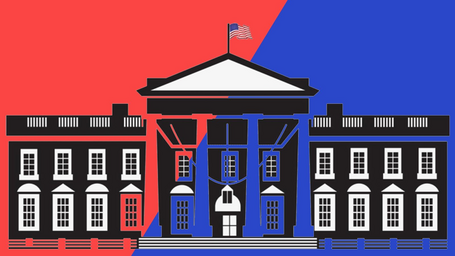The election of 2020 was indefinitely a wild ride. Whether you were thrown through a loop due to the long wait to hear the results of both presidential and legislative elections or the general closeness of the races, this November will surely be one for the books. However, 2020 was not the first election year to subject American citizens to political chaos, here are four historic elections- from 1800 to 2020.
- 1800
-
If you are singing “The Election of 1800” from “Hamilton” throughout reading the rest of this article, don’t look at me. Spoiler alert, Thomas Jefferson, a Democratic-Republican, won this one, but it has gone down in history as the “Revolution of 1800” because he defeated the Federalist Party incumbent, John Adams. Since the electoral college worked differently, parties nominated two candidates to the ticket, in this case, Jefferson and Aaron Burr on one and Adams and Charles Pinckney on another, and presidential electors voted for a president and vice-president individually.
Jefferson and Burr won by a landslide, but tied. The House of Representatives was to determine who would become president with sixteen available votes, one per each state. The candidate would have to receive nine electoral votes, and after several votes, Jefferson continued to only get eight. (This is where our trusty musical theatre man Alexander Hamilton comes in) Hamilton then encouraged Federalists, traditionally voting against Jefferson, to reconsider. To put it bluntly, Hamilton and Burr had prior beef, and Hamilton made it clear that even though Jefferson may exhibit beliefs that were “wrong,” they were better than having no principles like Burr.
However, the now-famous song from “Hamilton”, “The Election of 1800” has inaccuracies (that sometimes I choose to overlook because it’s just so dang catchy). The song says that Jefferson decides Burr would no longer be his vice president, but historically, Burr did serve his whole term. Instead, the ratification of the 12th amendment occurred in 1804.
- 1960
-
Although Kennedy dominated the electoral votes in the closest margin since 1916, he beat Nixon by only 120,000 in the popular vote, the closest margin in history. Kennedy also became the youngest president at 43 years old (even though Nixon was only four years older). Kennedy was also the first Catholic president, and the looming space race was a big issue of the election.
The election of 1960 also marked the first time presidential debates were televised. Until then, America knew their candidates as newspaper photos or voices over the radio, but 70 million Americans tuned in to watch this historic event. Despite Nixon previously having the upper hand with his knowledge of foreign policy and prior experience with radio debates, Kennedy was well-rested with a tan. Nixon, after visiting all 50 states on his campaign and spending time in the hospital, looked weak and unwell due to his pale complexion. His grey suit matched too closely with the studio set and he was repeatedly wiping sweat from his face. Presidential candidates did not debate each other face to face until 16 years later.
And what’s more, Alaska and Hawaii became states during this election cycle. Welcome, 48 and 49!
- 2000
-
The election of 2000 can be regarded as iconic for so many reasons. Maybe it’s the emergence of Democratic candidate Al Gore’s environmental policies, or the fact that the results of the election were disputed all the way up to the highest court in the land. Regardless of whatever reason you know this landmark political event for, the election of 2000 was equal parts essential and historic.
The race between Republican candidate George W. Bush and the Democratic candidate Al Gore was a hotly contested one. However, the state of Florida would prove crucial in determining the true winner of the election. As a swing state, the state plays an important role in not only making up a significant portion of the popular vote, but also the electoral college, with the winner of the state gaining a hearty 25 electoral votes towards the initial 270 votes required to win the election.
During election night, the state of Florida was called for both candidates multiple times, and in the early hours of November 7, 2000, it was determined that the margin of a little over 1,500 votes in favor of Bush was too close to call, culminating into a stalemate many historians have deemed “the perfect tie”. On the morning of November 8th, the Florida supreme court ordered a manual recount of the votes within the state, agreeing to do so in a four-three vote.
However, on November 9th the Supreme Court of the United States ruled in response to a petition raised by the Bush candidacy and opted to halt the recount. In a seven-two decision, the court ruled that the recount was unconstitutional, citing the equal protection clause of the Constitution. By a later five-four vote, the supreme court opted to halt the recount further, concluding that time had run out to devise a solution to discrepancies in recount standards, resulting in candidate Bush winning the state and its 25 electoral votes. In this circumstance, the results of the election were effectively decided by the supreme court case now dubbed “Bush v. Gore”.
- 2020
-
While by now you’re probably sick of thinking and reading about the 2020 election, there are quite a few ways this election has made history, and it’s only right to take note. Between defeating an incumbent, a woman of color as the Vice-President Elect, an all-time high for voter turnout, and Georgia going blue, this election has brought us many firsts, and some rarities that deserve celebration and recognition.
We knew that this election was going to be big, arguably the biggest of our lifetimes, but no one expected that more votes would be cast than ever before. It is estimated that 66.7% of eligible voters voted in this election, shattering records for turnout across the board. Not only does this mean that more people voted than ever before, but also that President-Elect Biden has received more votes than any other President elected to office. Only a mere seven states didn’t break their own turnout records, and Colorado is projected to have hit 76.5% turnout, second in the nation to only Minnesota, which is projected to hit 81.8% turnout. While turnout across the board is a victory for democracy on all levels, the 10% increase in youth voter turnout likely helped carry Biden to 270. With Biden getting support from 61% of people ages 18-29, and that youth turnout being even higher in battleground states, Biden has many thanks to give to the young people in this election.
While the history-making turnout of this election is an exciting first, there are plenty of non-firsts, but rarities that also should be noted. Trump is only the 10th incumbent President in United States History to lose re-election and only serve one term, joining the ranks of Presidents George H. W. Bush, Jimmy Carter, and Gerald Ford to name a few.
While Biden surpassed 270, there are notable state differences this election year when compared to a typical election year. Florida, always a highly contested swing state boasting a whopping 29 electoral votes, has voted for the overall winner of the election in every presidential election since 1996. This has made Florida a very important state to many campaigns, and a great indicator of how the candidate will perform across the country. In 2020 however, Florida broke its pattern and voted for Trump, leaving Biden initially behind but able to catch up in other battleground states. Some have said this indicates that Florida is no longer a swing-state, but is actually becoming a Republican stronghold. While it will likely take a couple more elections to prove this theory, it certainly does seem plausible. Another notable state in this election is obviously Georgia. This deep Southern, ruby-red state voted for a Democratic candidate for the first time since 1992 when President Clinton won the state. While Trump was ahead by a large margin on election night, as mailed votes from Atlanta and its surrounding suburbs began to be counted, Biden slowly but surely closed the margin, eventually pulling ahead. This is a tough loss for Republicans, as Georgia has long been considered a stronghold for the party.
Lastly, but certainly most notable, is the election of Kamala Harris as the first woman, and specifically woman of color, to the office of the United States Vice President. Of Jamaican and Indian descent, this California Senator is the first woman elected to the White House. This is a victory for women everywhere, all over the country and the world, and is hopefully a sign of a more diverse and representative future for American politics at every level.
2020 was an election year for the books, laden with all sorts of historic victories and losses. But a more important message lies in the past history of similar elections: history repeats itself. So it’s important to learn from the past, but keep your eyes trained on the future and the role you can play in it.
2020 was an election year for the books, laden with all sorts of historic victories and losses. But a more important message lies in the past history of similar elections: history repeats itself. So it’s important to learn from the past, but keep your eyes trained on the future and the role you can play in it.





